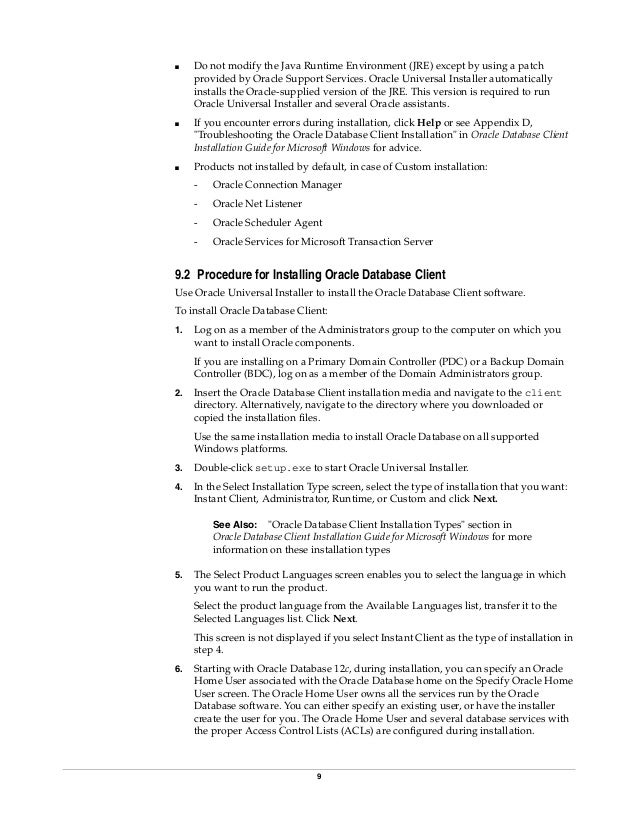Oracle Services For Microsoft Transaction Server 12c
Installation Introduction You can install as part of the Oracle Database Client. OraMTS service will be created for the Oracle Home you installed. Beginning in Oracle 12 c, each Oracle Home has its own OraMTS recovery Windows service. Also, beginning in Oracle 12 c, the OraMTS service runs as the Oracle Home user. Oracle Home User is the owner of Oracle Services that run from Oracle Home and cannot be changed after installation. It can be a Windows built-in account or a Windows User Account. For enhanced security, Oracle recommends choosing the standard Windows User Account as Oracle Home User for Oracle Database installations rather than a Windows built-in account.
The primary purpose of Oracle Home User is to run Windows services with Windows User Account. However, this user account (Oracle Home User) must be a low-privileged user account that should not be used for database administration. This ensures that Oracle Database services running under Oracle Home User have only the minimal privileges required to run Oracle products. The Windows User Account can be a Local User, a Domain User, or a Managed Services Account. In some cases, such as a software-only install, clone cycles, or an AddNode operation on the database, you may need to manually create the OraMTS service.
Please Sign up or sign in to vote. See more: C# Visual-Studio Oracle. [INS-20802] Oracle Services For Microsoft Transaction Server failed. I have older oracle database for visual studio 2010. I not sure it will effect my newer Oracle installation. What I have tried: http://www.oracle-class.com/?p=3040. With 12c client, Oracle Services for Microsoft Transaction Server is not a part of installation. You must explicitly run the OraMTSCtl utility to create the OraMTS Service. C: ORACLE_HOME bin>oramtsctl.exe -new. Once it is done, you can verify from services.msc that the OraMTS service is created.
For more information, see. Using Oracle Services for MTS with Oracle Data Provider for.NET, Managed Driver Oracle Data Provider for.NET, Managed Driver is a fully managed data provider consisting of 100% native.NET code introduced with Oracle Database 12c. ODP.NET, Managed Driver incorporates Oracle Services for MTS entire enlistment and commit functionality, within Oracle.ManagedDataAccessDTC.dll installed with the managed driver, allowing those functions to execute using managed code. The Oracle Services for MTS recovery service remains unmanaged.
The Oracle. Bowel Sound Learning Module Grade. ManagedDataAccessDTC.dll must be deployed with Oracle.ManagedDataAccess.dll for any ODP.NET, Managed Driver applications using distributed transactions. It can run alongside the unmanaged Oracle Services for MTS version if unmanaged data access drivers, such as ODBC, are also using distributed transactions on the same computer. There are two versions of Oracle.ManagedDataAccessDTC.dll, one for 32-bit.NET Framework and one for 64-bit.NET Framework, installed with ODP.NET, Managed Driver. While both versions of Oracle.ManagedDataAccessDTC.dll are fully managed, they must be platform-specific, because the MS DTC application programming interfaces are unmanaged code. Thus, ODP.NET, Managed Driver enlistment and commit functions call either the 32-bit or 64-bit MS DTC, depending on the platform.
The two versions of Oracle.ManagedDataAccessDTC.dll are located in the following directories: • 32-bit.NET Framework located in: OH odp.net managed x86 • 64-bit.NET Framework located in: OH odp.net managed x64 Deploy the Oracle.ManagedDataAccessDTC.dll from the directory appropriate for your.NET application's target platform, 32-bit or 64-bit. Oracle.ManagedDataAccessDTC.dll should not be directly referenced by a.NET application.
It will be implicitly loaded by ODP.NET, Managed Driver when using distributed transactions. The Oracle Services for MTS recovery service does not need to run in the same computer as ODP.NET, Managed Driver. Administrators can specify the host computer name that has a running recovery service in the.NET config file of the application. Manually Creating an Oracle MTS Recovery Service Starting with Oracle Database 12 c, Oracle Database on Windows software includes the oramtsctl.exe utility to enable manual creation of the OraMTS recovery service. Because ODP.NET, Managed Driver does not automatically create the OraMTS recovery service, running this utility creates the service. When run, the service will be created for the current Oracle home and runs as the Oracle Home User.If ODP.NET, Managed Driver can access an existing OraMTS recovery service running on the same computer or another computer, it is not necessary to run this utility. To manually create an Oracle MTS Recovery Service: • Install an Oracle Database.
• Open the command prompt. • Run this command: oramtsctl -new To delete an Oracle MTS Recovery Service run: oramtsctl -delete Usage oramtsctl [-host.] [-port ] [-ip ] [-dtchost ] [-cluster ] [-default] -new Create and start a new Oracler1MTSRecoveryService service. -delete [Oracle_home_directory] Delete Oracler1MTSRecoveryService of current home or specified home. -start Start Oracler1MTSRecoveryService service. -stop Stop Oracler1MTSRecoveryService service. -status Query Oracler1MTSRecoveryService service status. -config [-port ] [-ip ] [-dtchost ] [-cluster ] [-default] Show or set Oracler1MTSRecoveryService service configuration.
Use -default to reset Oracler1MTSRecoveryService configuration. -passwd Update Oracler1MTSRecoveryService service user password.
-trace [0-5] Show traces or set trace level. Set level 0 to turn off tracing. -trcdir [trace_directory] Show or set trace directory. Execute operation on host(s) identified by name(s) or IP address(es). Local host is used if option not specified.
-port Execute -new or -config with this option to specify a service port. Service port is configured automatically if option not specified. -ip Execute -new or -config with this option to specify an IP address. -default Execute -new or -config with this option to set default configuration.
Oramtsctl -new -host host1 host2.domain.com host3 -port 2033 Examples: Install the service with automatic configuration: oramtsctl -new Install the service on port 2032: oramtsctl -new -port 2032 Configure the service to use port 2033: oramtsctl -config -port 2033 Update the service user password: oramtsctl -passwd Install the service on several hosts and use uniform port 2033: oramtsctl -new -host host1 host2.domain.com host3 -port 2033.
